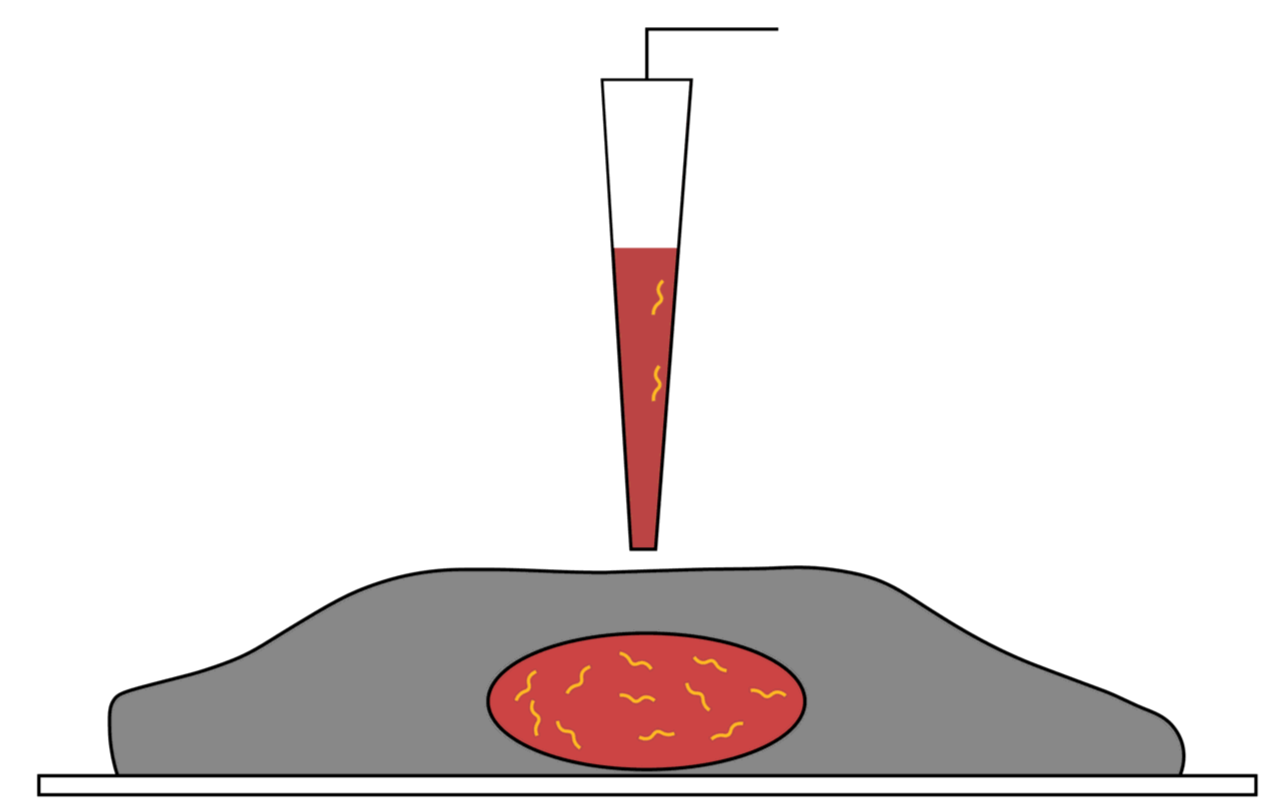
Local dosing using SICM can be used to precisely and selectively release capsaicin to various dendritic structures on DRG neurones. The nanopipette can be positioned with nanoscale accuracy over the cell and capsaicin delivery is voltage driven, as shown in the graphs. This has been used to investigate capsaicin dependent calcium influx via TRPV1 receptors6.
The concentration of molecules to a local area is dependent on the distance between the nanopipette tip and the surface. Therefore, an advantage of SICM is that the tip-sample distance can be controlled using a conductance threshold.
The concentration of molecules to a local area is dependent on the distance between the nanopipette tip and the surface. Therefore, an advantage of SICM is that the tip-sample distance can be controlled using a conductance threshold.

SICM can be used to controllably deliver molecules to a cell surface with high resolution for the study of biological processes. This can be done by either applying a voltage to the nanopipette and/or pressure to release the molecule of interest. The quantity of molecules being delivered to the surface can be controlled by changing the voltage/pressure in the nanopipette.


References
6 - Babakinejad, B. et al. (2013) ‘Local delivery of molecules from a nanopipette for quantitative receptor mapping on live cells’, Analytical Chemistry, 85(19), pp. 9333–9342. doi: 10.1021/ac4021769.
7 - Nikolaev, V. O. et al. (2010) ‘β2-adrenergic receptor redistribution in heart failure changes cAMP compartmentation’, Science, 327(5973), pp. 1653–1657. doi: 10.1126/science.1185988.
8 - Rodolfa, K. T. et al. (2005) ‘Two-component graded deposition of biomolecules with a double-barreled nanopipette’, Angewandte Chemie - International Edition, 44(42), pp. 6854–6859. doi: 10.1002/anie.200502338.
6 - Babakinejad, B. et al. (2013) ‘Local delivery of molecules from a nanopipette for quantitative receptor mapping on live cells’, Analytical Chemistry, 85(19), pp. 9333–9342. doi: 10.1021/ac4021769.
7 - Nikolaev, V. O. et al. (2010) ‘β2-adrenergic receptor redistribution in heart failure changes cAMP compartmentation’, Science, 327(5973), pp. 1653–1657. doi: 10.1126/science.1185988.
8 - Rodolfa, K. T. et al. (2005) ‘Two-component graded deposition of biomolecules with a double-barreled nanopipette’, Angewandte Chemie - International Edition, 44(42), pp. 6854–6859. doi: 10.1002/anie.200502338.
SICM can be used for the deposition of biomolecules, such as DNA and antibodies, onto a surface. Double barrelled pipettes allow the independent deposition of two different species on a surface. The voltage applied between the two electrodes in each of the barrels of the nanopipette creates an ion current through the droplet which forms at the tip. This allows control over the ion current and biomolecule deposition without the need to insert the sample into a bath of conducting solution. Fluorescently labelled antibodies have been deposited onto a PEI-coated glass surface8.
Local dosing application od KCL triggers the release of FM1-43 fluorescently labelled vesicles from hippocampal synaptic boutons (marked by red circle).
The fast, multi-delivery mode of this system is well suited for high throughput pharmacological experiments and could obtain hundreds of dose response curves on the surface of the cell in minutes.
The fast, multi-delivery mode of this system is well suited for high throughput pharmacological experiments and could obtain hundreds of dose response curves on the surface of the cell in minutes.

Local dosing using SICM can also be achieved using pressure to deposit molecules onto a cell surface in a highly localised fashion. This has been done to deposit receptor ligands at various regions of the membrane of cardiomyocytes to investigate the spatial localisation of β1- and β2-adrenergic receptors and their redistribution in the development of heart failure7.
The very small size of the nanopipette tip allows for highly localised deposition of molecules to the cell surface and, consequently, localised and selective stimulation of the receptor of interest.
The very small size of the nanopipette tip allows for highly localised deposition of molecules to the cell surface and, consequently, localised and selective stimulation of the receptor of interest.




Biomolecule deposition
Local dosing using pressure
Automated smart injection

ICAPPIC Limited (main office)
+44 (0) 208 383 3080
info@icappic.com
Address: The Fisheries, Mentmore Terrace, London, E8 3PN, United Kingdom

